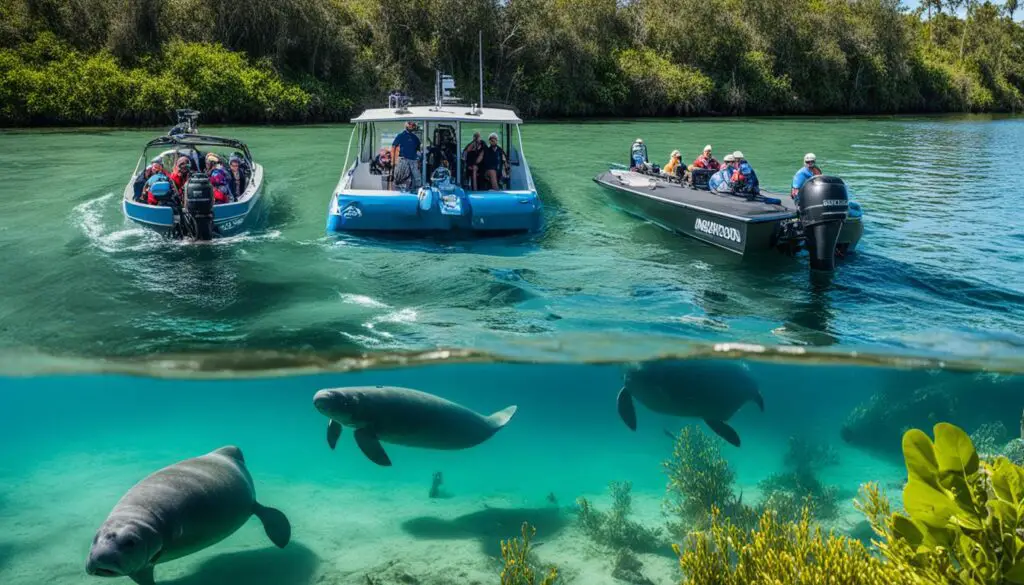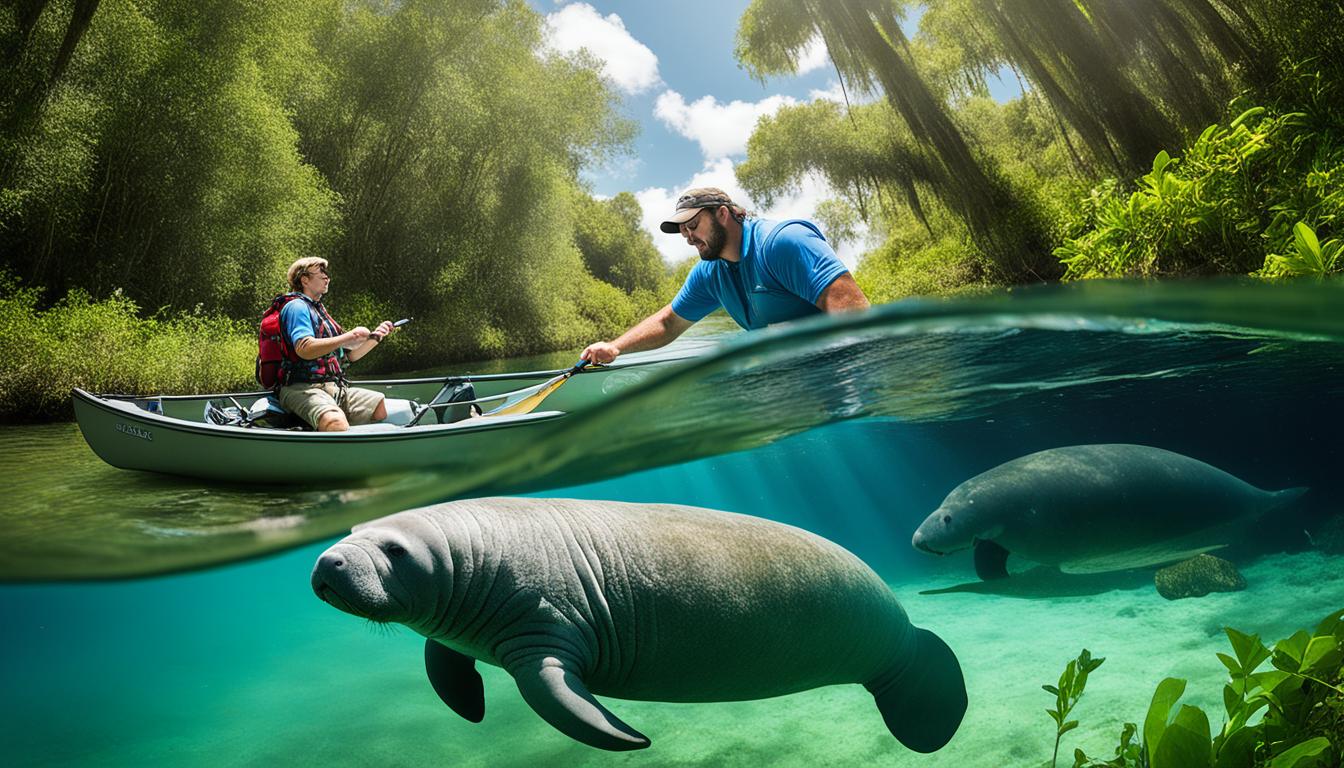Exploring manatee-human interactions is crucial for manatee conservation. These gentle giants have been on Earth for over 50 million years. However, they face threats from human actions. By learning about these interactions, we can understand manatee behavior and why we must keep a safe distance.
It’s vital to grasp the details of manatee interactions for education and policy-making. This knowledge helps us protect their homes. By learning more, we can adopt better habits that benefit both manatees and humans.
The Gentle Giants: An Introduction to Manatees
Think of manatees as the gentle giants of the sea. Florida manatees are a type of West Indian manatee. They are big and gentle. They weigh about 1,000 pounds, making them quite big.
These creatures have round faces and big flippers. They use these flippers to move through the water. Their look matches their calm nature.
Manatees mainly eat plants from the water. They help keep seagrass beds healthy. These beds are important for manatees and other sea creatures.
Florida manatees live in shallow waters like rivers and bays. These places give them plenty of food and keep them safe from predators. Knowing where they live helps us protect them.
What Makes Manatees Unique in Their Behavior?
Manatees are fascinating creatures with unique traits in their behavior and personality. They live in a semi-social way, showing little aggression and preferring friendly interactions. This makes them very likable to humans.
Curiosity drives much of their behavior. They use touch and smell to explore the world around them. You might see them come closer to you out of curiosity. Their moods change often, showing how complex their personalities are.
Since they don’t have natural predators, manatees feel safe around humans. This safety lets them interact with people in a gentle way. Their calm nature makes their interactions with humans both interesting and touching.
How do manatees interact with humans?
Manatees and humans have a unique relationship filled with curiosity and gentleness. These marine mammals often come close to people, showing a friendly side. It’s important to respect them and think about their well-being during these moments.
Curiosity and Approaches Towards Humans
Manatees are naturally curious about humans, leading to fun encounters. They might touch or nibble on our gear or clothes. This is their way of learning about the world. But, it’s key to remember that too much contact can stress them out.
The Importance of Non-Intrusive Encounters
It’s crucial to have non-intrusive encounters with manatees. Being too close can mess with their natural life and harm their health. Keeping a safe distance lets us enjoy watching them without hurting them. This way, we can learn to protect these amazing animals while still appreciating their presence.
The Impact of Human Activities on Manatee Behavior
Understanding how human actions affect manatees is key to saving them. Things like boating, fishing, and swimming change how manatees act and live. Noise and pollution stress them out, changing their eating and finding a mate habits. We need to know this to protect these gentle giants.
How Human Presence Alters Natural Habits
Humans have a big impact on manatees, changing their natural ways. More boats in the water change where they go and what they eat. This puts threats to manatees and their homes at risk.
Manatees might stay away from busy areas, missing out on food and places to have babies.
Accidental Harassment: Understanding Unintentional Threats
People sometimes bother manatees by mistake. They think manatees are safe and friendly. But this makes manatees stressed and they may react by moving away.
It’s important to know about these threats to manatees. Teaching people how to be safe around manatees can help reduce these risks.
Manatee Encounters: The Experience of Swimming with Manatees
Swimming with manatees lets you connect with these gentle giants. It’s important to engage with wildlife responsibly. This ensures both humans and manatees have a good time. There are rules to make sure these meetings are safe and memorable.
Guidelines for Respectful Interactions
For a great time with manatees, it’s key to follow certain rules. These rules help protect the animals. Important tips include:
- Stay calm and quiet to avoid startling the manatees.
- Avoid touching or chasing the manatees to maintain their natural behavior.
- Maintain a safe distance, allowing the manatees to approach you if they choose.
- Use environmentally friendly sunscreen to protect marine life.
Finding Friendly Manatees in their Natural Habitat
Knowing where manatees live can help you find them. They like shallow waters, seagrass beds, and warm springs. Here are some tips:
- Look for places like Crystal River or the Florida Keys where manatees are often found.
- Join tours with licensed guides who know how to interact with manatees properly.
- Check the weather, as manatees are more active on warm days.
Following these guidelines and tips makes your time with manatees special. It ensures a positive experience for everyone involved.
Manatee Conservation Efforts and Human Responsibilities
It’s crucial to protect manatees to ensure their survival. As caretakers of the planet, we all have a big role in keeping manatees safe. This includes fighting against the dangers of marine debris. By understanding these threats, we see our responsibilities and the importance of following manatee protection laws.
Protecting Manatees from Marine Debris
Marine debris is a big threat to manatees, harming their health and homes. Things like plastics and fishing gear can trap or be eaten by manatees, causing serious harm or death. Because of this, many manatees get hurt by debris.
To help, we need clean-up efforts and to teach people about proper waste disposal. This can make a big difference in keeping manatees safe.
Regulations Regarding Human-Manatee Interactions
Rules are in place to protect manatees and their homes. It’s important to know these rules to interact with manatees safely. These rules include limits on how fast you can go near manatee areas, where you can swim, and how close you should stay to manatees.
Following these rules keeps manatees safe and helps us live in harmony with them.

Educational Programs on Manatee Behavior and Conservation
Learning about manatees through educational programs changes how we interact with them. These programs teach us about manatees and why we need to protect them. They give us the knowledge to be kind and respectful when we see them in the wild.
Importance of Raising Awareness for Better Practices
Teaching people about manatees is key to their survival. By joining manatee education programs, you help spread the word about how to be gentle with them. This way, you can teach others to protect these marine animals too.
When you learn more about manatees, you can help save them. Being part of these programs makes you a hero in your community. By teaching others and acting responsibly, we can keep manatees safe for a long time.
FAQ
How do manatees interact with humans?
Manatees often show friendly and curious behaviors towards humans. They might nose or gently nibble. It’s key to keep a respectful distance to avoid stressing these gentle giants.
What are the best practices for respectful interactions with manatees?
Stay calm and keep a safe distance when with manatees. Avoid sudden moves in the water. Always respect their space and watch them from afar to keep them safe.
What impact do human activities have on manatees?
Human actions like boating and fishing can stress manatees. This affects their natural behaviors like eating and finding a mate. It’s important to be aware and act responsibly to lessen this impact.
How can I swim with manatees responsibly?
Choose guided tours that follow strict rules when swimming with manatees. Listen to the guides. Stay calm and still, letting the manatees come to you.
What are the major threats to manatees from human actions?
Big threats include losing their homes, getting tangled in fishing gear, and marine debris like plastic. Knowing about these risks helps protect manatees.
What conservation efforts are in place to protect manatees?
Efforts aim to reduce boat strikes, protect their homes, and control human-manatee interactions. You can help by joining awareness campaigns and following local rules.
How can educational programs help in manatee conservation?
Educational programs teach about how humans affect manatees and how to interact with them right. This knowledge lets people take actions that help manatee conservation.










